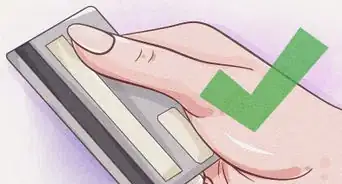wikiHow is a “wiki,” similar to Wikipedia, which means that many of our articles are co-written by multiple authors. To create this article, 21 people, some anonymous, worked to edit and improve it over time.
This article has been viewed 66,703 times.
Learn more...
Soccer is "The World's Game," and the Men's World Cup is the most watched program on earth. Yet, despite these accolades, many people still find it very difficult to watch and enjoy soccer. Part of this stems from a lack of understanding, and partly this is from the perceived "uneventful" nature of soccer compared to other sports. That said, "the beautiful game" is accessible to everyone, and the drama, intrigue, and excitement doesn't just come from goals. You just need to know where to look for it.
Steps
Understanding the Rules
-
1Understand the basic structure of the game. Soccer is a relatively simple game, rules wise. The objective is to score more goals than the other team by putting the ball in their net. Each team has 11 players working together to move the ball and defend against attacks, but they cannot use their arms or hands to do so. The key rules to know include:
- Each team has one goalie, who is allowed to use his/her hands to defend their goal, but only in the boxes around their goal.
- A goal is scored when the entire ball crosses the entire goal line and is within the frame of the goal.
- While light contact is accepted, a team of 3 referees is on the field to enforce the rules and make sure the players are attempting to attack the ball, not the other team.
-
2Know that the clock counts up to 90 minutes, not down to zero. One of the first things that confuses new soccer watchers is the clock. Unlike most other sports, the clock doesn't count down to zero, it counts up to 90:00. The game is broken into two even 45-minute halves with a 10-15 minute break in the middle. The clock also never stops, and the game only ends with the referee blows the final whistle (usually 2-3 times in a row).
- This is so the game doesn't stop unexpectedly. Soccer is all about flow, and if the clock was being constantly stopped, started, and checked like in football/basketball then the game would take forever.
- The game doesn't stop right at the 45' or 90' mark. Rather, the referee adds "stoppage time" to account for when the ball was out of bounds, a goal was scored, subs were made, etc. This means the actual game might stop at the 93-minute mark. Most TV broadcasts will show you how many extra minutes are being added in the corner of the screen as halftime or the end approaches.
Advertisement -
3Know the parts of the soccer field. A soccer pitch is a simple rectangle. There are a few extra marks, but the essential ones are all intuitive and easy to read.
- The Center Circle is where play begins. The ball is placed in the center middle of the field and the starting team gets to pass it. The other team cannot enter the circle until the ball has been touched.
- The Goal Box Also known as the penalty box or the 18-yard box, this is the rectangle on either end of the field in front of the goals. The goalie can only use their hands in this area.
- The Touch Lines are the long sides of the field. If the ball crosses over this line completely than the last team to touch the ball gives it to the other team for a throw-in.
- The Goal Lines The two end lines of the field. If the ball crosses this line and is within the fame of the goal, it is a goal. If it crosses the line, but not in the goal, then it is a goal kick or corner kick, depending on who touched the ball last.
-
4Learn how to judge what is and is not a foul. A foul is when a player makes illegal contact with another player on the other team by hitting, tripping, or kicking them. However, there is a lot of physical contact that is never called. Figuring out what is a foul and what isn't is one of the most difficult exercises in soccer, because there are few clear cut "infractions" to call like in football or basketball. The best way to remember a foul is to ask yourself -- did the player "play the ball," meaning did they make contact with the ball, or did they "play the player," by pushing/hitting/tripping the other player to win possession? FIFA defines the type of fouls as:
- Kicking, or attempting to kick, the other player.
- Tripping, or attempting
- Jumping/charging at someone
- Striking, or attempting
- Punching, or attempting
- Tackling
- Spitting
- Holding.
- Handling the ball.
-
5Understand the offside rule. This rule gives a lot of people consternation, but it is actually pretty straightforward. It simply states that a player cannot receive the ball from a teammate if they are behind the last defender. It is easiest to see with an example--
- USA Attacker Alex Morgan runs past the defender, leaving just her and the goalie between herself and the goal.
- Alex's teammate Megan Rapinoe who is in front of the defender Alex just ran by, passes Alex the ball. Alex is offside, and the referee blows the whistle to stop the game.
- This rule is only complicated because of the speed of play, and several important tweaks to the rule. Still, they are straightforward:
- If Alex does not touch or play the ball,' but is still in an offside position, she is not offside.
- If Megan passes the ball, and Alex runs into an offside position to get it, she is not offside.' What matters is where she is when the ball is passed, not where she gets it.
- If Alex and Megan are on their defensive half of the field, then they cannot ever be offside.
- You can be offside on a shot or missed pass, too, if you get the ball before anyone else touches it. You cannot be offside if the other team passes or shoots the ball.
-
6Know that most infractions are restarted with a free kick. If there is a foul or someone is offside, then play is restarted by a free kick awarded to the opposite team. No person on the other team can be within 10 yards of the ball before it is kicked, at which point normal play resumes.
- If the ball goes out over the sides of the field it is restarted by a throw-in, which must be done with both hands, over the head.
- If an attacker misses the goal and it crosses the end line, the goalie gets a free kick from their goal. If a defender kicks the ball out over their own end line the offensive team gets a free kick from the corner of the field.
-
7Understand the yellow and red cards are given for serious fouls/infractions. A yellow card is basically a warning, telling the player that their foul was careless, reckless, or excessive. A red card is far more serious, as it means the player is immediately ejected from the game and their team is forced to play with one less player for the rest of the game.
- Two yellow cards in the same game, for the same player, always leads to an automatic red card.
- Some infractions, like violent play, intentionally fouling or using your hand to stop and obvious goal, and swearing or threatening the referee, are automatic red cards.
Appreciating the Game
-
1Revel in the flow of the game, not the goals. Soccer is not high-scoring, but that doesn't mean it isn't exciting. Soccer is about flow, the give and take between teams as they try to figure each other out and attack weak spots while simultaneously defending their own. Soccer is much more about tension and rapid, sudden changes of pace and momentum then constant scoring. Goals are incredibly difficult to score, making each one a huge, special moment many minutes in the making.
- Consider goals the culmination of a long attack -- like a battle being fought and contested in the trenches before one side makes big, successful push.
- The more you understand about soccer, the more enjoyable it becomes beyond just flashy goals. Soccer is too organic, creative, and fluid to be broken down into individual plays.
-
2Pay attention to the individual match-ups on the field. A soccer game consists of hundreds of small challenges and individual battles. It could be a wing player attempting to slice and dice a defender or a striker jockeying to win a header in the box. These individual battles, more often than not, determine the entire game. An attacker, for example, could be barely getting by his defender before getting tackled. But if you notice him/her getting more and more shots off as the game continues, you can tell he's beginning to get the upper hand. All it takes is one goal for the battle, and the game, to be decided.
-
3Understand the roles and freedoms of each position. How do the individual players move, attack, and defend to aid their team. What are they doing when they don't have the ball? This is where games are won and lost, because all 11 players need to be working together no matter where the ball is.
- Defenders. Do they give the other team space, or follow them everywhere? Do they stay close to home, or do they roam up on attack? A fast and attacking defender like Philip Lahm or DeAndre Yedlin is often the most exciting player on the field, winning a tackle and then taking the ball right back up the field on an attack. Weaker teams or defenders give the offense lots of time and space, waiting for a 2nd defender to join them instead of attacking on their own.
- Midfielders. What do the players in the middle of the field do? This is where the tempo of the game is dictated, and they are the most important tactical players on the field. Are they going out wide or backward a lot? If so, they're likely probing for holes in the defense, sitting back and waiting for chances. Midfielders that dribble, attack, and pass forward a lot are trying to push the team forward for a goal, exposing their defenses by pressuring the other team to respond quickly to their attacks.
- Attacker/Striker. Are they checking backward often, getting the ball and passing it quickly? Are they holding far up the field, using size and speed to get the ball, turn and shoot? Are they running onto passes often then putting moves and tricks on defenders to win space? An attacker is there to create havoc for the defenders, even when they don't have the ball, and these match-ups are often the most crucial.
-
4Note how teams create and erase space. Managing the field on the fly is the secret weapon of a good soccer team. Passing is not always used directly to attack the goal. Rather, it is used to force the other team to move, shift, and adapt, potentially making a mistake and leaving a hole open. The basic tenet of soccer tactics is manipulating the other team to give you space in front of the goal for a shot when you're attacking, or closing down space so that they other team can't move forward when playing defense.
- Notice how many balls are played to players on the run. This is because they are running into open space. They need to get the ball before a defender joins them and closes down the opening.
- Is a team "bunkering in" by placing all of their defenders near their goal? This is used to prevent goals, especially if they have a lead. It can, however, lead to lots of free shots from farther out which will crack the facade of a defending team.
- Watch the defense of a great team, like Italy, to see how a team masterfully controls space. You'll notice that they move as one consistent line, eliminating pockets of space in front of and behind them as a unit.
-
5Check the team's formations. Much like defensive patterns in football, soccer teams have general patterns for their players that greatly impact their style of play. Formations are always written from the back upwards, excluding the goalkeeper. So a 4-4-2 would mean there are 4 defenders, 4 midfielders, and 2 attackers/strikers.
- The "classic" formation, a 4-4-2 is a solid, well-rounded strategy that has been used for decades. That said, it lacks in creativity and is often used for defensive or counterattack-oriented teams.
- A team's formation says a lot about their strategy going forward. Do they have 1 striker and a big midfield? If so, they're likely looking to control the center of the field and run players up into space on the wings. Are they sitting back with 5 defenders? Where players are placed tells you how the team wants to attack and defend.
-
6Note a team's style. Your appreciation of soccer will shoot up incredibly once you notice not only what teams or players are doing, but why. How do the tactics, match-ups, and pace of play come together in a good team? How are they attacking (along the sides of the field a lot, through the middle, by hitting big huge crosses up the field?) and how successful are they? Do all of their passes go through one player, or is everyone on the field touching the ball?
- It can help to watch how the best teams in the world play a cohesive, recognizable game. Brazil is known for flash, talent, and speed. Italy is known for slower play and stalwart defense. The USA is a quick, counterattacking team that tries to make the most of its limited chances against better teams with lightening-fast attacks.
- If you watch a lot of American sports, think about each attack like a play in football. Whereas a one football team might focus on the passing game to be effective and another the running, a soccer team might rely on the wings (sides) to attack defenders and put crosses into the box or a few big players to muscle out and attack up the middle. The only difference is that soccer plays are fluid and organic, not chosen ever 15 seconds, so strategies are constantly evolving.
-
7Revel in the theater and drama of a great game. They are beautiful contests marked by near misses, technical brilliance, passionate players, and non-stop, commercial free push and pull. Tactics and substitutions are dissected with chess-like precision, good teams fail to find the goal when they should have 5 goals already, and underdogs can sneak a goal in even after 85 minutes of constant pressure. Soccer is about 2-3 large climaxes in the midst of an intense game, not constant scoring, and is best enjoyed as such.[1]
-
8Go to a game in person. The best way to catch the soccer bug is to be in the stands. You can feel the collective rise and falls of emotion from your fellow fans, see both team's tactic happening across the entire team, and you'll learn a few colorful chants in the process. Like most sports, soccer is best enjoyed in person, when you can really get swept up into the game.
Finding Great Games
-
1Watch soccer year round by switching between many different leagues and tournaments. Soccer is on year-round, as there are so many different leagues, tournaments, and teams across the world that you can almost always be sure of finding a game. While the availability of certain games depends on where you live and your TV provider, following your favorite teams is getting easier and easier in the online era. Moreover, the widespread nature of soccer means that almost every country and area will have a team to watch.
- If you want to watch a game, but can't find it on TV, search for the game and date, plus the word "streaming" in your internet browser. Many soccer blogs will post all of the different ways to see the game.
- Check out your local teams, including semi-pro teams. Much like baseball, soccer players and teams can move up and down in the rankings from season to season and even become national stars after several years. The rankings and leagues are fluid, and the enormous global market means players move frequently.
-
2Find out which national leagues are currently in season. Just about every country on the planet has a soccer league, and while most of them play through the winter months, many of them are staggered in order to make room for international tournaments later in the year. These teams are colloquially known as "clubs."
- The English Premier League, generally considered the best league in the world, plays from late August to early May. La Liga (Spain), Seria A (Italy), Bundesliga (Germany), and Ligue 1 (France), the other major European leagues, all run on similar timelines.
- Major League Soccer, America's league, runs from March to October. Liga MX, the Mexican league, runs in both the summer and winter.
-
3Choose a team or league to follow to get invested in the scores. All sports are more fun if you have someone to root for. Pick a team or league based on whatever feels right to you, whether it is your hometown, has your favorite player, or simply seems like a fun team to root for. Even individual leagues have their own intricacies, quirks, and unique facets:
- The English Premier League is where all the best players go because it has the most money. The play is crisp, tactical, and fast, and there are a lot of teams that can compete in any given game.
- La Liga, the Spanish League, is fast and flashy. The players are technical and the game is beautiful, and the top clubs, like Real Madrid, are among the best in the world every single year.
- The Bundesliga, Germany's league, is technical and physical, and produces many of the best players in the world. It is less watched, perhaps, than other leagues in Europe, but contains some of the highest quality play.[2]
- The MLS is a young, quickly growing league marked by physicality and young, developing players.
-
4Watch out for the major club tournaments. Almost every league in the world doesn't actually have a playoff. Instead, points are tallied up from every game, and the highest point total wins the league. However, there are a variety of major tournaments each year for club teams, and this is almost always the highest quality soccer you can watch every year.
- The Champions League is a tournament between all of the best clubs from every country in Europe. Qualifying takes place over the summer and winter, with the final in May.
- The FA Cup is a tournament between every pro or semi-pro team in England, no matter what their standing is.
- Every continent has versions of this cup (such as South America's Copa Libertadores) but the European League is the best-known tournament.
-
5Follow your country's national team in major world tournaments. A country's national team is made up of only citizens of that country, and these teams compete in the world's biggest tournaments, like the World Cup. International soccer is played in the summer and consists of a series of games, qualifications, and tournaments that ultimately culminate in the World Cup every 4 years.
- Friendlies are practice games that mean little, but are essential for team building and testing out players and strategies. Since most players leave to play for their club team during the year, these are crucial practice games for coaches.
- Qualification for major tournaments, such as the Gold Cup, the World Cup, and the Confederations Cup, take place every single year. These crucial games determine, ultimately, what 32 countries make it to the World Cup.
- Tournaments These round-robin and knock-out events are what every national team lives for. Winning some of them, like the Gold Cup, gets you an automatic free bid to the World Cup, the ultimate tournament in soccer.[3]
-
6Follow soccer blogs, teams, and accounts to be in the know about upcoming games. There is so much soccer on TV at any given time, it is hard not to find something worth watching. But the deluge of information can be overwhelming, especially for new fans. If you don't have a team or can't figure out who to watch, the best place to start is the English Premier League. It runs from August to May, and all of the games are played on Saturday and Sunday, always, making it easy to sit down and get a good game even if you aren't in the know about the schedules.[4]
-Step-1.webp)
-Step-2.webp)
-Step-3.webp)
-Step-4.webp)
-Step-5.webp)
-Step-6.webp)
-Step-7.webp)
-Step-8.webp)
-Step-9.webp)
-Step-10.webp)
-Step-11.webp)
-Step-12.webp)
-Step-13.webp)
-Step-14.webp)
-Step-15.webp)
-Step-16.webp)
-Step-17.webp)
-Step-18.webp)
-Step-19.webp)
-Step-20.webp)
-Step-21.webp)


























































